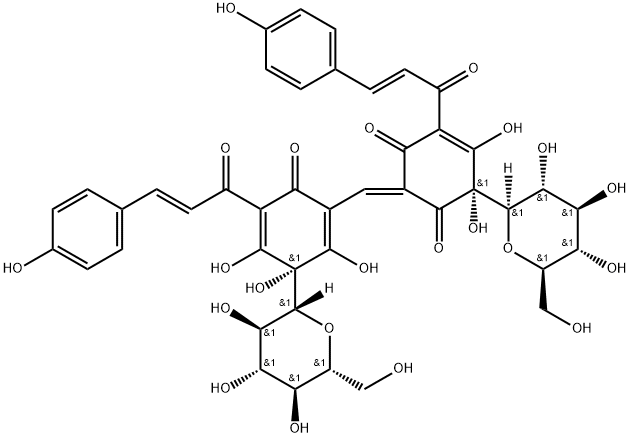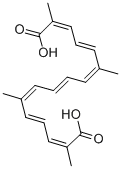Safflower oil
Synonym(s):Safflower seed oil from Carthamus tinctorius seed
- CAS NO.:8001-23-8
- Empirical Formula: NULL
- Molecular Weight: 0
- MDL number: MFCD00132216
- EINECS: 232-276-5
- SAFETY DATA SHEET (SDS)
- Update Date: 2024-12-18 14:07:02
What is Safflower oil ?
Chemical properties
Refined safflower oil is a clear, viscous, yellow to pale-yellow liquid, with a slight vegetable odor.
Occurrence
Saffl ower is found in the Mediterranean, Europe, and the United States.
The Uses of Safflower oil
safflower oil (Carthamus tinctorius) is a carrier oil also considered hydrating to the skin. It consists primarily of linoleic acid triglycerides. Safflower oil is a non-comedogenic raw material obtained from the plant’s seeds.
The Uses of Safflower oil
Pharmaceutic aid (vehicle, oleaginous).
The Uses of Safflower oil
Safflower Oil is an unsaturated oil obtained from the safflower seed of the plant carthamus tinctorius. it consists mainly of linoleic and oleic fatty acids. it is used principally as a drying oil in the usa.
What are the applications of Application
Safflower seed oil from Carthamus tinctorius seed is a raw oil without preservatives
Definition
Drying oil from safflower (carthamus) seed, somewhat similar to linseed oil. It is nonyellowing. Contains 78% linoleic acid (unsat- urated fatty acid).
Production Methods
Refined safflower oil is the fatty oil obtained from the seeds of
Carthamus tinctorius L. (type I) or from seeds of hybrids of
Carthamus tinctorius L. (type II) by expression and/or extraction followed by refining. Type II refined safflower oil is rich in oleic (cis-
9-octadecenoic) acid. It may contain a suitable antioxidant.
Safflower oil USP 32 is the refined fixed oil yielded by the seed of
Carthamus tinctorius Linne′ (Fam. Compositae).
brand name
Liposyn (Abbott).
General Description
Pale yellow oily liquid with a weak odor.
Air & Water Reactions
Insoluble in water.
Reactivity Profile
Safflower oil react with acids to liberate heat. Heat is also generated by interaction with caustic solutions. Strong oxidizing acids may cause a vigorous reaction that is sufficiently exothermic to ignite the reaction products. Flammable hydrogen is generated by mixing with alkali metals and hydrides. React slowly with oxygen in the air to thicken and become rancid.
Health Hazard
Oil is essentially nontoxic. Contact with eyes can cause mild irritation.
Fire Hazard
Flash point data for Safflower oil are not available; however, Safflower oil is probably combustible.
Pharmaceutical Applications
Safflower oil is mainly used as an oleaginous vehicle in oral and
topical formulations. It is also used as a component of parenteral fat
emulsions for the preparation of parenteral nutrition solutions.
Safflower oil has been used as a vehicle in the development of an
oral dosage form containing a novel viral-specific inhibitor of the
replication of human rhinoviruses. It has also been used as a
solvent for a capsule formulation containing a new antilipemic
agent; formulations containing safflower oil were found to have the
greatest bioavailability in dogs compared with formulations
containing PEG 300 or water.
A topical lotion containing 3% safflower oil is commercially
available, and parenteral fat emulsions containing a mixture of
safflower oil 5% and soya oil 5%, or 10% and 10%, respectively,
have been administered as part of total parenteral nutrition regimes.
Safflower oil is used as a food, being consumed in the form of
soft margarine, salad oils, and cooking oils. It is also used in
cosmetics products such as soaps, lotions, creams, and hair-care
preparations.
Safety
Safflower oil is an edible oil and generally presents no significant
health hazards following eye contact, skin contact, oral ingestion, or
inhalation. Skin irritation or allergic reactions, or eye irritation may
occur. Ingestion of large doses can cause vomiting. Safflower oil
may cause diarrhea.
LD50 (mouse, IP): >50 g/kg
storage
Safflower oil thickens and becomes rancid on prolonged exposure
to air. It is also sensitive to light. Safflower oil should be preserved in
tight, light-resistant containers. Refined safflower oil should be
stored in a well-filled, airtight container, protected from light.
Parenteral fat emulsions containing safflower oil are destabilized
by electrolytes; severe droplet coalescence in the emulsion occurs
3–5 days after the addition of 10% v/v dimethyl sulfoxide, and after
10 days if 5% v/v is added. Parenteral fat emulsions are prone to
bacterial and fungal growth. Generally, fat emulsions containing
safflower oil or soybean oil show similar growth patterns, although growth of Candida albicans has been reported to be higher
in safflower oil containing fat emulsions than in other types of
emulsion.
Incompatibilities
Safflower oil is incompatible with strong oxidizing agents.
Regulatory Status
Included in the FDA Inactive Ingredients Database (topical lotion). Included in the Canadian List of Acceptable Non-medicinal Ingredients. Included in an intravenous fat emulsion (Liposyn II) available in the USA. Included in a capsule formulation available in Canada and in a non-medicinal capsule formulation previously available in the UK. It is also a component of a Canadian enteral nutrition preparation.
Properties of Safflower oil
| Density | 0.921 g/mL at 25 °C(lit.) |
| refractive index | n |
| Flash point: | >230 °F |
| storage temp. | room temp |
| form | Oil |
| color | Pale Yellow |
| Odor | bland |
| Water Solubility | 0.1 g/100 mL at 19 ºC |
| Stability: | Stable. Combustible. Incompatible with strong oxidizing agents. Thickens and becomes rancid upon prolonged exposure to air. |
| EPA Substance Registry System | Safflower oil (8001-23-8) |
Safety information for Safflower oil
Computed Descriptors for Safflower oil
Safflower oil manufacturer
New Products
(S)-3-Aminobutanenitrile hydrochloride 4-Methylphenylacetic acid N-Boc-D-alaninol N-BOC-D/L-ALANINOL Tert-butyl bis(2-chloroethyl)carbamate 3-Morpholino-1-(4-nitrophenyl)-5,6-dihydropyridin- 2(1H)-one Furan-2,5-Dicarboxylic Acid Tropic acid 1-Bromo-3,5-Di-Tert-Butylbenzene S-2-CHLORO PROPIONIC ACID ETHYL ISOCYANOACETATE 2-Bromo-1,3-Bis(Dimethylamino)Trimethinium Hexafluorophosphate 4-IODO BENZOIC ACID 3-NITRO-2-METHYL ANILINE 1-(2,4-DICHLOROPHENYL) ETHANAMINE (2-Hydroxyphenyl)acetonitrile 4-Bromopyrazole 2-(Cyanocyclohexyl)acetic acid 4-methoxy-3,5-dinitropyridine 1-(4-(aminomethyl)benzyl)urea hydrochloride 2-aminopropyl benzoate hydrochloride diethyl 2-(2-((tertbutoxycarbonyl)amino) ethyl)malonate tert-butyl 4- (ureidomethyl)benzylcarbamate Ethyl-2-chloro((4-methoxyphenyl)hydrazono)acetateRelated products of tetrahydrofuran








You may like
-
 Safflower seed oil, from carthamus tinctorius seed CAS 8001-23-8View Details
Safflower seed oil, from carthamus tinctorius seed CAS 8001-23-8View Details
8001-23-8 -
 Safflower oil CAS 8001-23-8View Details
Safflower oil CAS 8001-23-8View Details
8001-23-8 -
 Safflower seed oil from Carthamus tinctorius seed CAS 8001-23-8View Details
Safflower seed oil from Carthamus tinctorius seed CAS 8001-23-8View Details
8001-23-8 -
 1975-50-4 98%View Details
1975-50-4 98%View Details
1975-50-4 -
 2-HYDROXY BENZYL ALCOHOL 98%View Details
2-HYDROXY BENZYL ALCOHOL 98%View Details
90-01-7 -
 2-Chloro-1,3-Bis(Dimethylamino)Trimethinium Hexafluorophosphate 221615-75-4 98%View Details
2-Chloro-1,3-Bis(Dimethylamino)Trimethinium Hexafluorophosphate 221615-75-4 98%View Details
221615-75-4 -
 14714-50-2 (2-Hydroxyphenyl)acetonitrile 98+View Details
14714-50-2 (2-Hydroxyphenyl)acetonitrile 98+View Details
14714-50-2 -
 118753-70-1 98+View Details
118753-70-1 98+View Details
118753-70-1